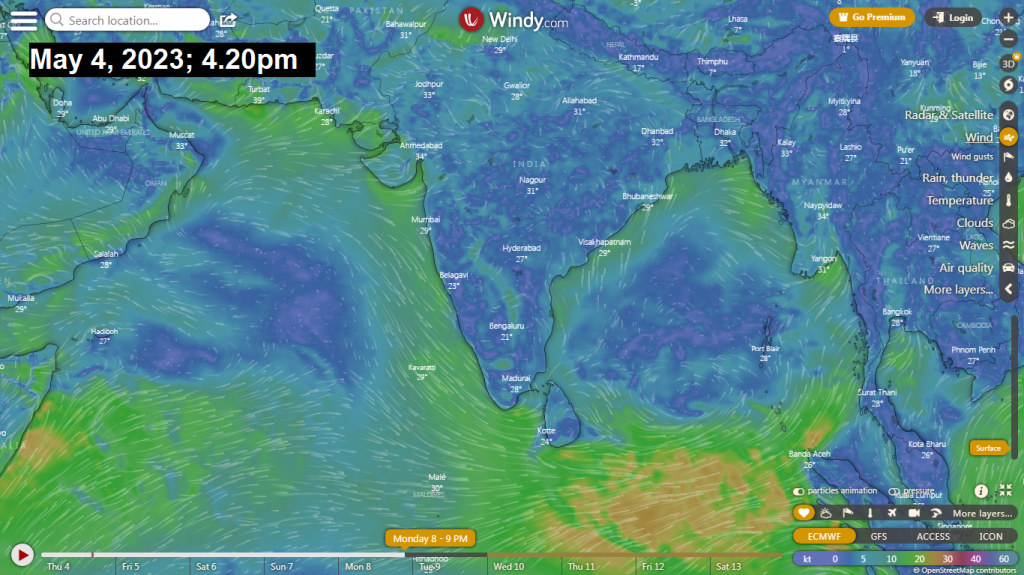

New summer cyclone likely to take place in Bay of Bengal around May 8



A summer cyclone is likely to take place in the Bay of Bengal around May 8, called Mocha. India has seen a few major cyclones in the Bay of Bengal during April and May in the last few years. However, according to data from the India Meteorological Department (IMD), October and November constitute the peak cyclone season for India.
So far, there is no forecast regarding Mocha’s landfall over India’s coast. But predicting the path of summer cyclones is very difficult, IMD Director General Mrutyunjay Mohapatra told a local news channel Odisha TV.

The cyclonic storm predicted by forecast website Windy.com
The frequency of genesis of cyclones, or cyclogenesis, is maximum in May, Mohapatra said in a press statement May 4, 2023. The details of Cyclone Mocha’s path and intensity will be provided after the low-pressure area is formed around May 7, 2023.
Read more: Odisha braces for Cyclone Mocha, likely to hit around May 8
Let us take a look at some of the other recent summer cyclones that hit India.
Fani is considered the worst cyclone to hit Odisha in this century. It was also the longest-lived cyclone in the Bay of Bengal ever observed.
The extended storm period went on for 11 days in the sea and land put together. What made it even more surprising was that it had formed in the pre-monsoon season, in April.
Amphan was the first super cyclone in the Bay of Bengal in the last 21 years and made landfall near Digha in West Bengal on May 20, 2020. It ravaged almost the entirety of south Bengal, including Kolkata.
Read more: There is a chance of cyclone formation in the Bay of Bengal in the second week of May
It was also the costliest tropical cyclone on record in the North Indian Ocean, with reported economic losses of approximately $14 billion in India, according to the World Meteorological Organization.
Warm subsurface waters in the Bay of Bengal likely helped fuel it. Marine heatwaves also likely helped intensify the cyclone from Category 1 (cyclonic storm) to Category 5 (super cyclone) in less than 36 hours.
Nisarga originated in the Arabian Sea and made landfall June 3, 2020 on the Maharashtra coast. It was the strongest tropical cyclone to strike the state in June since 1891. Mumbai broke the brunt of it, along with Palghar, Thane and Raigad districts. Parts of Madhya Pradesh were also affected.
Read more: Why were there no cyclones in October and November?
Cyclone Yaas, forming in the Bay of Bengal, devastated several parts of West Bengal May 26 and impacted nearly 10 million people. Coastal areas experienced squalls in the range of 100 kilometres or more, apart from large-scale flooding.
Lessons learnt from Amphan helped save inhabitants of West Bengal’s Sundarbans region.
Tauktae originated in the Arabian Sea and made landfall along Gujarat’s Saurashtra coast on May 17, leaving a trail of destruction. Three states in the country’s west — Maharashtra, Saurashtra and Kutch region in Gujarat and south Rajasthan — were heavily affected.
Read more: Simply put: Life after cyclone Fani
Asani had formed May 7 in the Bay of Bengal and dissipated May 12. It had pulled the monsoon winds into the Andaman Sea but did not pull any further. Very heavy rain was reported in Kerala, Andhra Pradesh and Odisha.
We are a voice to you; you have been a support to us. Together we build journalism that is independent, credible and fearless. You can further help us by making a donation. This will mean a lot for our ability to bring you news, perspectives and analysis from the ground so that we can make change together.

Comments are moderated and will be published only after the site moderator’s approval. Please use a genuine email ID and provide your name. Selected comments may also be used in the ‘Letters’ section of the Down To Earth print edition.